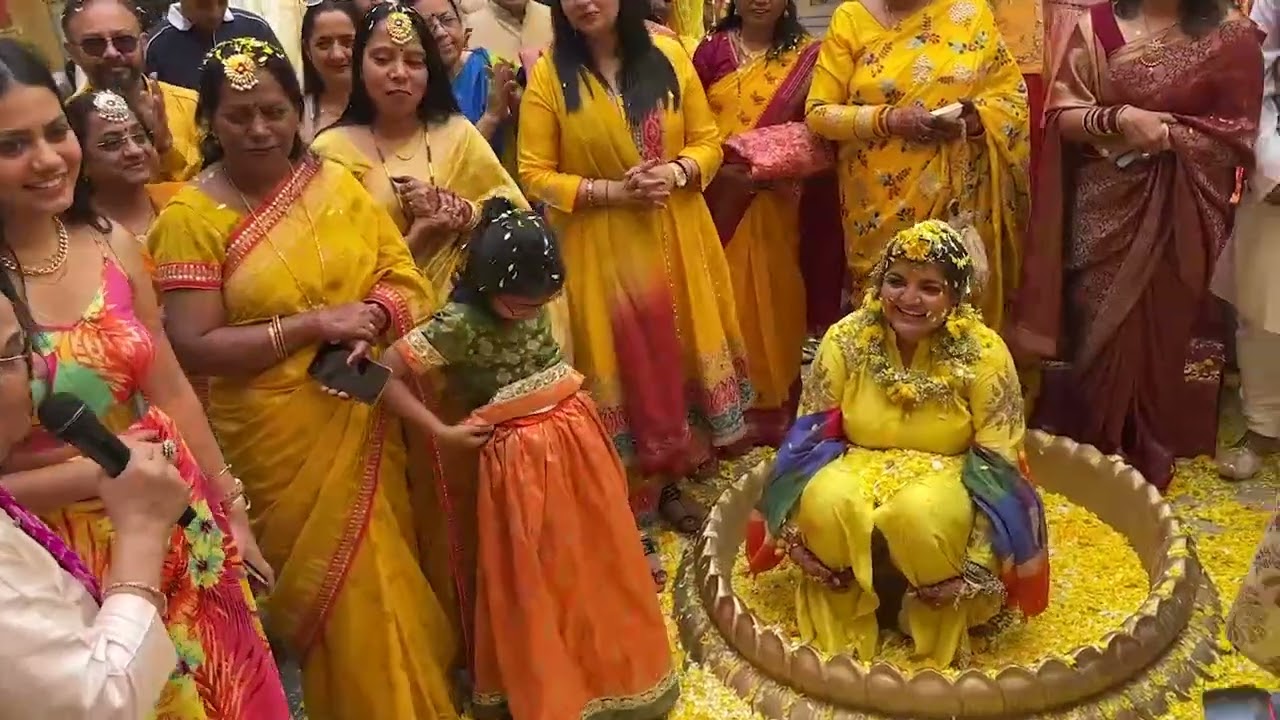Haldi Ceremony

In the grand tapestry of Indian weddings, each ritual and ceremony adds its unique brushstroke, creating a vibrant mosaic of tradition and culture. Among these cherished customs, the Haldi ceremony stands out as a celebration of love, purity, and familial bonds. Rooted deeply in ancient traditions, the Haldi ceremony, also known as Pithi or Ubtan, holds a special place in the hearts of Indian families, symbolizing auspicious beginnings and the blessing of the soon-to-be-wed couple. Let’s embark on a journey to unravel the layers of significance woven into this age-old ritual.
Historical Origins: The origins of the Haldi ceremony can be traced back centuries to the Indian subcontinent. It finds its roots in Ayurveda, the ancient Indian system of medicine, which extols the virtues of turmeric as a potent healer and purifier. Turmeric, with its vibrant yellow hue and myriad medicinal properties, has long been revered in Indian culture for its ability to cleanse and rejuvenate the body and soul. Thus, the application of turmeric paste on the bride and groom-to-be during the Haldi ceremony is believed to bestow upon them not only physical radiance but also spiritual blessings.
Symbolism and Rituals: At the heart of the Haldi ceremony lies symbolism rich in meaning and tradition. The ceremony typically takes place a few days before the wedding, in the homes of the bride and groom, amidst close family and friends. The paste, made from turmeric, sandalwood powder, rose water, and other fragrant herbs, is applied to the face, arms, and feet of the couple-to-be by their loved ones. This ritual is not merely a cosmetic adornment but a sacred act imbued with profound significance.
The yellow color of the Haldi paste symbolizes prosperity, fertility, and the sun, which is considered a source of life and energy in Indian culture. By applying the Haldi paste, the bride and groom are believed to absorb these auspicious qualities, ensuring a blissful and prosperous union. Additionally, the act of applying the paste is also seen as a form of protection from the evil eye and negative energies, safeguarding the couple’s future happiness.
Beyond its symbolic value, the Haldi ceremony serves as a joyful occasion for bonding and celebration within the family. It brings together relatives and friends, who participate in the ritual with gusto, singing traditional folk songs and showering the couple with blessings and good wishes. The playful smearing of Haldi paste on each other’s faces often leads to laughter and camaraderie, strengthening the bonds of love and affection among all present.
Regional Variations: While the core essence of the Haldi ceremony remains consistent across India, there are variations in customs and rituals depending on regional and cultural differences. In some parts of the country, such as Punjab and Rajasthan, the Haldi ceremony is celebrated with great pomp and grandeur, accompanied by lively music, dance, and elaborate decorations. In contrast, in South India, the ceremony may be more subdued, with a focus on simplicity and spiritual significance.
In certain communities, additional rituals are incorporated into the Haldi ceremony to enhance its sacredness. For instance, in some Bengali weddings, a traditional ritual called “Dodhi Mangal” is performed, where the bride and groom are fed a mixture of yogurt and rice before the Haldi application, symbolizing nourishment and fertility.
Modern Trends: In recent years, the Haldi ceremony has undergone a transformation, blending age-old traditions with modern elements to reflect the evolving tastes and preferences of contemporary couples. While the essence of the ritual remains intact, there is a growing trend towards personalization and customization. Couples are increasingly incorporating creative themes, décor, and entertainment into their Haldi ceremonies, making them memorable experiences for all involved.
Moreover, the Haldi ceremony has also become a popular subject for pre-wedding photography and videography, with couples opting for professional shoots to capture the candid moments of joy and affection shared during the ritual. These images serve as cherished mementos, preserving the beauty and warmth of the Haldi ceremony for years to come.
Conclusion:
In the kaleidoscope of Indian weddings, the Haldi ceremony shines brightly as a beacon of tradition, love, and togetherness. Rooted in ancient customs and imbued with profound symbolism, this sacred ritual transcends generations, uniting families and communities in celebration of new beginnings. As couples embark on the journey of marriage, the Haldi ceremony serves as a reminder of the rich cultural heritage that binds them and the enduring blessings that accompany their union. In its simplicity and splendor, the Haldi ceremony continues to weave its magic, illuminating the path towards a lifetime of happiness and fulfillment.





